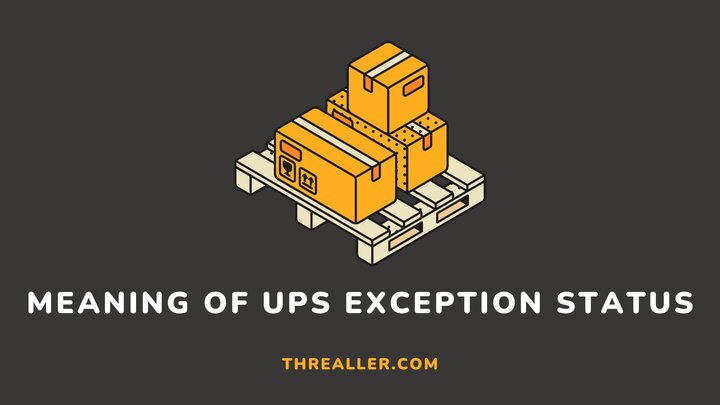In the UPS network, scanned packages get to their final destination or experience an exception. An “exception” status means your package won’t be delivered as scheduled due to unforeseen reasons.
Your order will get the exception status if the package is damaged, features an incorrect address, your signature was not received, or there was a public holiday, to name a few.
Once you get this notification, check the UPS tracking portal to confirm the new (estimated) delivery date. If there is no update after waiting for a few days, there are steps you need to take.
This guide explains what a UPS delivery exception is, the major causes, and how to avoid and resolve it.
What Does a “UPS Exception” Status Mean?

An exception status or a delivery exception in UPS is a tracking notification sent to the package recipient to indicate a delay or change in the delivery schedule.
To identify the cause of the delay, you need to insert a tracking ID in the “Shipment Progress” section on the UPS website. You will also learn about the new delivery date for your package. For further inquiries, you can always reach out to UPS customer service.
9 Causes of UPS Exception
Several factors may be responsible for the delayed delivery of a package. Let’s take a look at them:
1. Incorrect Address
Your package may be delayed for a few days if you or the sender provide an incorrect address. One way to identify UPS exceptions due to an incorrect address is that they come with an ‘action-required’ update.
Once you get this notification, you or the sender have to update your address information. On the other hand, you may need to contact the seller if your package is under UPS Mail Innovations, UPS SurePosts, or UPS Freight Collect services.
2. Clearance delay
Delivery exceptions also occur when your package experiences a clearance delay. This may be due to missing or incorrect documents. In this case, you or UPS need to contact the seller or retailer to provide these documents.
3. Technical glitches
System downtime or technical glitches will also delay your package for about 24 hours or more, depending on how fast it can be resolved. This can only resolved by being patient and waiting until operations are restored.
Retailers can use another courier if the package is time-sensitive.
4. Lost and damaged items
If your package gets lost or damaged before arriving at or within a UPS facility, a replacement must be provided before delivery can resume. While this may be rare, resolving it requires patience.
5. Public holidays or weekends
UPS rarely delivers packages on weekends or public holidays like Christmas and Thanksgiving Day. The only time your package may arrive at these periods is if it is under UPS guaranteed delivery options like the UPS 2nd Day Air.
Otherwise, you should expect your package to be delayed until the holiday is over or the next business day (for weekend delays).
6. Adverse weather conditions
UPS packages can also experience an exception due to severe weather conditions like wildfire, heavy rain, and flood. Some of these conditions can damage items and render roads unpassable.
Hence, drivers have to wait until the condition of the road is better or fall back on other contingency plans. This slight delay may be responsible for the exception status you are seeing.
7. Missed delivery
UPS offers different delivery options. For packages that require a direct signature, the recipient or their neighbors must sign for them before the package will be released.
Missing such a delivery may result in an exception if the drivers cannot find a secure spot at your residence to drop the item. To avoid this, ensure you leave a note on what to do for delivery drivers if you are unsure of your availability.
UPS will attempt delivery thrice. Hence, if you miss the first attempt, try not to miss the next. Should you miss all attempts, you will have to pick up your package at an Access Point within 10 calendar days.
8. Security or regulatory delays
For shipments that contain toxic or hazardous materials, special security and regulatory practices apply. These extra procedures may extend the delivery date by a few days.
9. Aggressive pets
Some customers also have aggressive pets like dogs that can dissuade a delivery driver from dropping your package at a secure spot within your property. In this case, drivers may leave a note and will attempt delivery the next day.
How to Resolve a UPS Exception [As a Customer & Seller]
As a customer
While an exception status is usually nothing to worry about as it gets resolved within 24 to 48 hours, UPS expects customers to be:
- Be Patient: Generally, exceptions get resolved within 24 to 48 hours. This means you only need to be patient should your package does not arrive on the agreed delivery date.
- Contact the seller: If there is no significant process after waiting for several days, you may need to contact the carrier. Sometimes, UPS sorting centers may be busy, and it may take days to contact a seller regarding an issue with your package.
- Contact them: You can also contact UPS if you have no way of contacting the carrier. They will investigate your order and tell you what to do or when to expect your package.
As a seller or retailer
Retailers who actively track packages will easily spot exceptions. When they do, they:
Contact UPS: Retailers or package senders can also contact UPS to know the reason for the delivery delay. The response they get will help them know if there is a reason for the delay or if it is just due to congestion.
Contact the customer: Retailers should also feel free to contact their customers if the delay is not due to an error. The best way to do this is via email. This will reassure them and give your brand a positive impression.
Initiate a refund or new delivery: If the package is delayed because it got damaged, you may need to replace it or issue a refund if there is no replacement. Ensure you do this promptly to avoid a negative impression.
5 Ways to Avoid UPS Delivery Exception Status
1. Follow the courier’s guidelines
When preparing a parcel for delivery, following UPS’s packing and labeling guidelines closely is best. For example, UPS advises package senders to use a 2-inch wide tape for sealing.
Neglecting this directive and using a string or ribbon to seal your package may result in an exception.
2. Be exact with weight measurement
For shipment methods that rely on the weight of your package for pricing, you must include the exact weight in your package’s information. Do not give an estimate.
Get a scale, weigh your parcel, and indicate it in supporting documents. An estimate or a wrong weight description could lead to an exception or package rejection.
3. Use durable labels
Labels or tags contain essential identification information that should remain visible throughout delivery. Hence, it is necessary to stick to durable labels because fragile ones fade when exposed to moisture and can delay package delivery.
4. Verify the delivery address and provide a tracking ID
As a seller, it is vital to verify the correctness of the receiver’s address more than once. Once it is confirmed, you can provide them with the correct tracking ID of the package.
This will help them prepare for the delivery of the package.
5. Operate a multi-courier software
You do not have to rely on UPS only. Using multi-courier shipping software like Shippo can help you avoid exceptions. They also help with accurate label printing, price comparisons, and customs forms printing (for international shipments).
FAQs
What does a customs clearance exception mean?
Custom clearance exception means a specific event, such as holidays, is delaying the delivery of your parcel.
How long does a shipment exception last?
An exception usually gets resolved within seven days of the delivery date. You can request a refund within this period if the delay is too detrimental to your business.
What are delivery exception updates?
Delivery expectation updates are an essential feature in the UPS network that provides updates to reflect a new delivery date(s) for your package.
The Bottom Line
A UPS exception status can be problematic, especially if you are expecting or sending a time-sensitive item. Nevertheless, understanding the reason for the exception will help you with a faster resolution.
In addition, when preparing a package for delivery or shipment, you should adhere to UPS requirements and provide accurate documentation.
I hope you found this guide helpful. For further reading, please see the meaning of FedEx delivery exceptions.
Thanks for reading.
